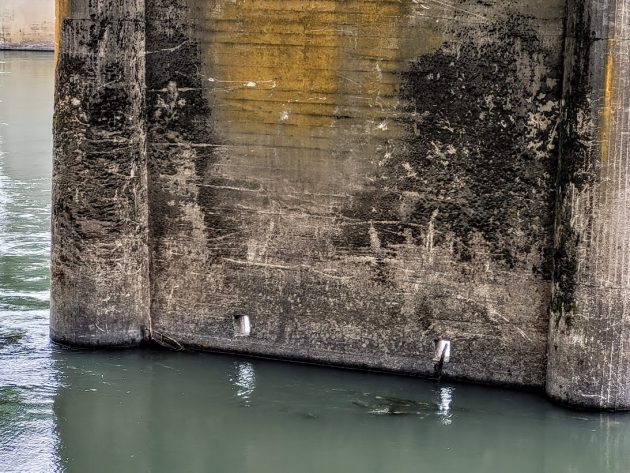
The Ellsworth Street Bridge overhead on Oct. 30, 2022; the Lyon Street Bridge on the left.
On a bike ride last weekend I found myself under the Albany bridges over the Willamette River. That’s when I noticed a structural detail I had not seen before, something I wish somebody could explain.
The concrete pier of the Ellsworth Street Bridge closest to the northern riverbank has a couple of rectangular holes near the bottom. On Oct. 30, when I saw them, they were close to the water line.
Pretty soon the river level will rise because of rain and releases from the dams upstream in the basin. Then the openings will disappear until next summer when the river drops again.

A closer look at the holes shows how thin the pier’s concrete wall is.
What, pray tell, are those holes for? I presume they were put there when the bridge was built. But why? What is their purpose?
The holes reveal that the pier is not as thick as you would think if you just looked at the ends. Maybe less than a foot? As far as I could tell, the other in-water piers don’t have holes like these.
Meanwhile, what else is new with this venerable bridge, designed by the team of legendary Oregon bridge engineer Conde Balcom McCullough and completed in 1925?
ODOT apparently is still planning to increase the clearance above the bridge deck from 14-feet-11-inches to 16 feet.
Over the years, the overhead beams have been hit several times by equipment being towed over the bridge. ODOT wants to lower the risk of that happening again.
On its website, the state transportation department says the clearance project’s design will take until 2023, and construction may take place late in ’23 or in 2024. (Nothing happens fast where ODOT is concerned.)
The design, by the way, is budgeted to cost around $736,000. Construction is estimated to cost $5.1 million, according to the website.
The holes in the pier don’t have anything to do with the clearance above the deck. But maybe, by the time they raise the beams, somebody will have told me what those mysterious holes are for. (hh)
And now … the answer. This story had been up less than a day when ODOT spokeswoman Angela Beers-Seydel saw it and came back, via email, with this: “I saw your question about those holes. One of the ODOT divers (they do our underwater bridge and culvert inspections) says that the holes are from the construction form when the bridge was built. A lot of the older bridges were built this way.”


I’m looking forward to an update on the purpose of these holes. I wish my grandfather was still with us, he was the engineer who worked with McCullough on this bridge (and many others in Oregon).
I’m sure HE would have had an answer!
The holes are where the water goes thru.
I have no doubt the frequenters of this blog will have no problem offering up their uneducated speculation on bridge construction and how they would do it better.
Similar to your own uneducated opinion?
Boy, you really got me Cheryl.
I wonder if it is a possibility that the holes on the pillars had anything to do with the larger ships that used to come down through the Willamette before they dredged the river, I couldn’t really tell by the picture how old the holes looked if they our original to when the pillars were put in place originally or newer, it’s also a possibility that maybe they had something to do with when they had the Willamette Queen riverboat down at Monteith Park before they took it up to Salem back in the 1990’s??
A mystery encased in an enigma buried deep inside a question mark.
Always figured the holes were to help with erosion.
They are there in minimize bridge scouring.
Not an engineer, but it may be to change the water flow to reduce scouring at the base…
https://www.sciencedirect.com/science/article/pii/S2090447916301022
Bob’s response was far better than ODOT’s ‘the holes are there because that’s how they built bridges back then’ dismissive response, so how can we divert taxpayer dollars to him instead?
That’s an unfair summary of ODOT’s response. The actual response said the holes were left from the forms used to pour the concrete when the bridge was built, which makes sense.
Thanks for these suggestions. But read the postscript of the updated version of this story above. ODOT has provided the answer. The openings were left when the construction forms — to pour the concrete — were removed as the bridge was built.
The City of Albany did nothing to assist the Willamette Queen to have the ability to stay in Albany. We loved it! I was on it when the War of 1812 Overture with cannon with fireworks were out and over the Willamette – what a night!
I agree with you that the Albany did nothing to help keep the Willamette Queen here, but if my memory serves me right they made a big deal out of it coming here and once it was here did nothing to help keep it here, no different than letting the Timber Carnival fade away, and dredging Timber Linn lake to put in a “amphitheater” that is used for one concert a summer during the Art & Air festival, my thought was they were all for the Willamette Queen at the time, very sad how much this town has lost over the years that are such great memories for the people old enough to remember those things!
For those interested in the history of bridges in Oregon, the Alsea Bay Bridge Interpretive Center in Waldport is an excellent place to visit.